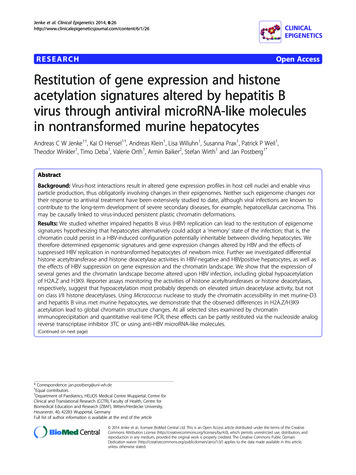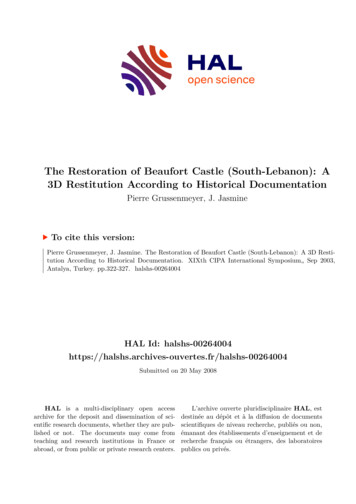
Transcription
Jenke et al. Clinical Epigenetics 2014, ent/6/1/26RESEARCHOpen AccessRestitution of gene expression and histoneacetylation signatures altered by hepatitis Bvirus through antiviral microRNA-like moleculesin nontransformed murine hepatocytesAndreas C W Jenke1†, Kai O Hensel1†, Andreas Klein1, Lisa Willuhn1, Susanna Prax1, Patrick P Weil1,Theodor Winkler1, Timo Deba1, Valerie Orth1, Armin Baiker2, Stefan Wirth1 and Jan Postberg1*AbstractBackground: Virus-host interactions result in altered gene expression profiles in host cell nuclei and enable virusparticle production, thus obligatorily involving changes in their epigenomes. Neither such epigenome changes northeir response to antiviral treatment have been extensively studied to date, although viral infections are known tocontribute to the long-term development of severe secondary diseases, for example, hepatocellular carcinoma. Thismay be causally linked to virus-induced persistent plastic chromatin deformations.Results: We studied whether impaired hepatitis B virus (HBV) replication can lead to the restitution of epigenomesignatures hypothesizing that hepatocytes alternatively could adopt a ‘memory’ state of the infection; that is, thechromatin could persist in a HBV-induced configuration potentially inheritable between dividing hepatocytes. Wetherefore determined epigenomic signatures and gene expression changes altered by HBV and the effects ofsuppressed HBV replication in nontransformed hepatocytes of newborn mice. Further we investigated differentialhistone acetyltransferase and histone deacetylase activities in HBV-negative and HBVpositive hepatocytes, as well asthe effects of HBV suppression on gene expression and the chromatin landscape. We show that the expression ofseveral genes and the chromatin landscape become altered upon HBV infection, including global hypoacetylationof H2A.Z and H3K9. Reporter assays monitoring the activities of histone acetyltransferases or histone deacetylases,respectively, suggest that hypoacetylation most probably depends on elevated sirtuin deacetylase activity, but noton class I/II histone deacetylases. Using Micrococcus nuclease to study the chromatin accessibility in met murine-D3and hepatitis B virus met murine hepatocytes, we demonstrate that the observed differences in H2A.Z/H3K9acetylation lead to global chromatin structure changes. At all selected sites examined by chromatinimmunoprecipitation and quantitative real-time PCR, these effects can be partly restituted via the nucleoside analogreverse transcriptase inhibitor 3TC or using anti-HBV microRNA-like molecules.(Continued on next page)* Correspondence: jan.postberg@uni-wh.de†Equal contributors1Department of Paediatrics, HELIOS Medical Centre Wuppertal, Centre forClinical and Translational Research (CCTR), Faculty of Health, Centre forBiomedical Education and Research (ZBAF), Witten/Herdecke University,Heusnerstr. 40, 42283 Wuppertal, GermanyFull list of author information is available at the end of the article 2014 Jenke et al.; licensee BioMed Central Ltd. This is an Open Access article distributed under the terms of the CreativeCommons Attribution License (http://creativecommons.org/licenses/by/4.0), which permits unrestricted use, distribution, andreproduction in any medium, provided the original work is properly credited. The Creative Commons Public DomainDedication waiver ) applies to the data made available in this article,unless otherwise stated.
Jenke et al. Clinical Epigenetics 2014, ent/6/1/26Page 2 of 15(Continued from previous page)Conclusions: Increased sirtuin activity might lead to global histone hypoacetylation signatures, which couldcontribute to the HBV-induced pathomechanism in nontransformed hepatocytes. Using several techniques tosuppress HBV replication, we observed restituted gene expression and chromatin signature patterns reminiscent ofnoninfected hepatocytes. Importantly, ectopic expression of antiviral short-hairpin RNA, but not microRNA-likemolecules, provoked intolerable off-target effects on the gene expression level.Keywords: histone deacetylation, sirtuins, CpG signaling, non-coding RNA, HBV, HCCBackgroundTo enhance virus particle production, virus-host interactions lead to manipulation of gene expression patterns inthe infected cells, which necessarily involve changes in theepigenome. Neither such virus-induced host epigenomechanges nor the response of these changes to therapieshave extensively been studied to date, although it seemsobvious that over the long term, several viral infectionscan contribute to the development of severe secondarydiseases, which may be causally linked with persistentplastic chromatin deformations. For example, enforcementof hepatitis B virus (HBV) replication over long periodscan eventually contribute to the development of chronichepatitis B, liver cirrhosis and hepatocellular carcinoma(HCC). Globally, more than 350 million people are chronically infected with HBV; thus chronic hepatitis B belongsto the list of most common infectious diseases [1]. Themost common mode of HBV transmission is verticallyfrom mother to child with up to 90% of the neonates bornto hepatitis B surface antigen (HBsAg)-positive mothersrunning the risk of becoming infected [2]. Chronic diseaseoccurs mainly when the infection happens early in lifeduring childhood. Adults become chronically diseased inonly 5 to 10% of cases, whereas chronification rates can behigher than 90% when infants become infected in the firstsix months of life. Possible sequels of chronic hepatitis Bare liver cirrhosis and cancer. In fact, chronic hepatitis Bcorrelates with a 37-fold elevated probability of developingHCC [3]. However, the molecular reasons for these agerelated differences in chronification remain unknown todate. It is also not known whether antiviral interventionslead to a restitution of epigenome patterns in host cellsmanipulated by HBV. Alternatively, one could hypothesizethat hepatocyte nuclei adopt a ‘memory’ state of the HBVinfection even if viral replication is suppressed; that is, thechromatin might persist in an HBV-manipulated configuration, which could be inheritable between dividing hepatocytes and could contribute to elevated secondary diseasesusceptibility.Apart from the outstanding clinical relevance of elucidating the early pathomechanisms of HBV infection, thispathogen can serve as minimalistic model for virus-hostinteractions in general. The small 3.0 to 3.2 kbp HBVgenome encodes only four genes, giving rise to sevenproteins: HBVgp1 (polymerase), HBVgp2 (large S protein/middle S protein/S protein), HBVgp3 (X protein)and HBVgp4 (precore/core protein). The genome consists of partially double-stranded DNA, which is replicated via an RNA intermediate by reverse transcriptionthrough the HBV polymerase. Chronic HBV infectionsare accompanied by the persistence of the viral genomiccovalently closed circular DNA (cccDNA) as stable episomes within hepatocyte nuclei, serving as a templatefor viral protein expression [4]. It is assumed that the Xprotein (HBx) acts as a transregulator and contributes tothe malignant transformation of hepatocytes, and evidence increases that hepatocyte transregulation involveschromatin-modifying mechanisms, which act on the epigenomes of both the cccDNA and the host cells. HBxenrichment apparently leads to elevated DNA methyltransferase (DNMTs) levels [4-6]. In hepatocellular carcinoma cells transfected with wild-type HBV genomes,the histone acetyltransferase (HAT) p300 becomes recruited to the cccDNA. Concomitantly, levels of acetylated histones H3 and H4 (H3ac/H4ac) associated withthe cccDNA increase and viral replication is enhanced. Incontrast, p300-binding and H3ac/H4ac are reduced inhepatoma cells expressing a nonfunctional HBx [5]. Moreover histone deacetylases (HDACs) become recruited tothe cccDNA via HBx, suggesting that this protein is critical for chromatin structure regulation of the cccDNA [4].Although a few available studies underline the relevanceof chromatin-modifying mechanisms for episomal stabilityof the cccDNA, HBV replication, viral gene expression andhost cell reprogramming, most of that data resulted fromstudies in HCC cell lines or biopsies. In those samples, earlyepigenetic trans-acting decisions are indistinguishable fromlater events, and most models do not focus on the increased chronification susceptibility in infected infants. Asa consequence, spatiotemporal dynamics of regulatory networks at the onset of chronic hepatitis B infection are notyet understood, but might be relevant for therapy decisionsand antiviral drug development. To contribute, we compared the abundance of 80 mRNAs corresponding to genesrelevant for HCC development in HBV-negative and HBVpositive nontransformed hepatocytes, which derived fromnewborn mice. We analyzed underlying chromatin signatures and investigated the response of hepatocytes upon
Jenke et al. Clinical Epigenetics 2014, ent/6/1/26impaired HBV replication using nucleoside analogs or RNAinterference.ResultsAccumulation patterns of several messenger RNAs differbetween noncancer and hepatocellular carcinomahepatocytes upon chronic hepatitis B virus infectionIt is clear that the time-displaced development of hepatocellular carcinoma can be an endpoint of chronic hepatitisB infection, and numerous piloting studies in the field havealready compared gene expression profile differences in cellline models such as HepG2 hepatoma cells and HBVpositive HepG2.2.15 cells. However, the differences between chronic nontransformed HBV-positive hepatocytesand transformed HBV-positive hepatocytes have not beenextensively studied so far. To confirm the importance ofthese differences, we studied the relative differential accumulation of numerous messenger RNAs (mRNAs) inHBV-positive murine liver biopsies (1.2.32 (Tg [HBV 1.3genome] Chi32) lineage), which corresponded to morethan 80 genes associated with liver cancer developmentand housekeeping genes by quantitative real-time polymerase chain reaction (qPCR) (Table 1; [see Additional file 1:Figure S1A]). The biopsies were obtained from 24-monthold mice (n 5), which did not develop HCC or whichdeveloped HCC (N 5). Our analyses showed - dependingon whether HSP90AB1 and ACTB were used for normalization or, alternatively, a combination of HSP90AB1,ACTB and GAPDH was used - that approximately 11 to24% of the examined mRNAs were differentially deregulated. This observation highlights why it is reasonable tofocus on nontransformed models of HBV infection inorder to elucidate mechanisms in the hepatocellular regulome, which become modulated by HBV and potentiallycontribute to the development of HCC.Selective gene deregulation events are associated withchronic hepatitis B virus infection in nontransformedhepatocytesTo study gene expression changes and underlying epigenome signatures in nontransformed hepatocytes uponchronic HBV infection, which might possibly be relevantfor HCC development, we made use of the immortalized,nontransformed murine hepatocyte cell lines met murinehepatocytes (MMH)-D3 (HBV-negative) and hepatitis Bvirus met murine hepatocytes (HBV-Met) (HBV-positive),which were derived from newborn mice [7,8]. We analyzed the expression of over 80 liver cancer-related genesusing qPCR arrays on reverse-transcribed RNA isolatedfrom five biological replicates of MMH-D3 and six biological replicates of HBV-Met cell lines. Whereas mostmRNAs did not exhibit significant differences in theirrelative abundance, CDH13 (B03) was significantly upregulated in HBV-Met. In contrast, CDKN2A (B06), WT1Page 3 of 15(G10) and DLC1 (B11) were downregulated in HBV-Metwhen compared to MMH-D3 (Table 1; Figure 1A; [seeAdditional file 1: Figure S1B]) (all P 0.05). Several othermRNAs showed a tendency to be up- or downregulated,whereas most of these fold-changes did not reach significance (P 0.05). KDR (D07), IGFBP1 (D03) and IGFBP3(D04) seemed to be slightly upregulated. In contrast,IGF2 (D02), CDH1 (B02), fragile histidine triad protein/FHIT (C06), gluthatione S-transferase pi 1/GSTP1 (C10),cyclin-dependent kinase inhibitor 1A/CDKN1A (B04) andsignal transducer and activator of transcription 3/STAT3(F11) seemed to be slightly downregulated. Also betaglucuronidase/GUSB (H01), which was referred to as thehousekeeping gene in the array, was significantly downregulated. We therefore decided not to use GUSB fornormalization. Remarkably, we recognized that moregenes became downregulated than upregulated. We werethen interested in whether our observations made on theMMH-D3 and HBV-Met cells also hold for infectedhumans. To evaluate, we compared the expression of selected human genes between three HBV-negative andthree HBV-positive age- and gender-matched adolescents(non-HCC) [see Additional file 1: Figure S1C] and gathered information from the literature (Table 1). The HBVnegative control group exhibited elevated transaminases,justifying diagnostic needle aspiration liver biopsies. Eventually, no evidence for liver diseases was found in any ofthe cases. In agreement with our observations in theMMH-D3/HBV-Met mouse cell system, CDH13 mRNAwas significantly enriched in HBV-positive specimens, butIGFBP3 also seemed to be slightly upregulated. Concomitantly, DLC1 and CDKN2A mRNAs were significantlydownregulated. No significant difference was found forthe accumulation of IGFBP1 and KDR mRNAs betweenthe HBV-positive and HBV-negative juvenile liver samples,whereas WT1 was highly enriched in the HBV-positivespecimens. Remarkably, this was the only observed starkcontrast between cultivated nontransformed murine hepatocytes and human samples.Antiviral treatment entails partial restitution of metmurine hepatocytes-D3-like expression patterns, but alsocauses severe side effects when short-hairpin RNA is usedfor hepatitis B virus suppressionTo verify the functional connection between the presence of the HBV genome and the observed differencesin gene expression patterns, we suppressed HBV replication in HBV-Met using different approaches. Thereafter,we compared the expression of selected genes in thesecells with untreated HBV-Met (Figure 1A,B,C,E-G).With respect to our initial experiment, these genes wereselected from three groups. Group 1 was composed ofthe ten most upregulated genes in the HBV-Met, group2 of the ten most downregulated genes, and group 3 was
Changes in gene expressionGene/functionHBV-Methuman chronicversus MMH-D3 hepatitis BChanges in CpGsignalinghuman HCCHBV-Met vs.MMH-D3humanhepatitisB/HCCReferenceslow 5meC hyper5meC in 1 Yu, BMC Cancer. 2002 PMID: 12433278high 5hmeC tumor (HCC)1CDH13 Regulation of cellcell contactsup (P 0.01)no Pubmed hit; upregulation observed inchronic HBV infection (n 3) versusHBV-negative liver biopsies (n 3),P 0.05no Pubmed hitKDR (VEGFR2) Regulationof angiogenesisuncertain(up, P 0.05)no Pubmed hit; no significant changeobserved in chronic HBV infection (n 3)versus HBV-negative liver biopsies (n 3)up2,3,4Nano Pubmedhit2 Yoshiji, Hepatology. 2001 PMID: 11283848 (mouse)3 Shimamura, J Gastroenterol Hepatol. 2000 PMID:10921418 4 Yoshiji, Hepatology. 1999 PMID: 10534339IGFBP1 IGF regulation/proliferationuncertain(up, P 0.05)no Pubmed hit; no significant changeobserved in chronic HBV infection (n 3)versus HBV-negative liver biopsies (n 3)no Pubmed hitNano PubmedhitNaIGFBP3 IGF regulation/proliferationuncertain(up, P 0.05)no Pubmed hit; no significant changeobserved in chronic HBV infection (n 3)versus HBV-negative liver biopsies (n 3)normal5Nano Pubmedhit5 Adamek, Oncol Rep. 2013 PMID: 23784592down7,8down6,7,8low 5meCmoderate5hmeChyper5meC(hepatitis B HCC)1,6,7,81 Yu, BMC Cancer. 2002 PMID: 12433278 6 Li, Clin CancerRes. 2004 PMID: 15569978 7 Kaneto, Gut 2001 PMID:11171828 8 Shim, Cancer Lett 2003 PMID: 12565176up9,10,11Nahyper5meC(HCC)12,135 Wu, Oncogene. 2001 PMID: 11439330 9 Uesugi, JGastroenterol. 2013 PMID: 23142971 10 Perugorria, CancerRes. 2009 PMID: 19190340 11 Sera, Eur J Cancer 2008 PMID:18255279 12 Yu, Cell Res. 2003 PMID: 14672555 13 Zhang,Clin Cancer Res. 2007 PMID: 17289889down14,15,16NaCDKN2A Tumorsuppressordown(P 0.038)WT1 Tumor suppressordown(P 0.01)down early: normal hepatocytes expressingHBx5/HBV-positive biopsies5 versus ‘significant upregulation observed in chronicHBV infection (n 3) versus HBV-negativeliver biopsies (n 3)’DLC1 Tumor suppressordown(P 0.01)significant upregulation observedin chronic HBV infectionJenke et al. Clinical Epigenetics 2014, ent/6/1/26Table 1 Overview of experimental and literature evidence for several differentially expressed genes and CpG signaling in mouse and humanselevated14 Dong, Cancer Epidemiol. 2009 PMID: 19766077 155meC (HCC)15 Wong, Cancer Res. 2003 PMID: 14633684 16 Leung-Kuen,PLoS One 2013 PMID: 23826380Abbreviations: CDH13 cadherin 13, CDKN2A cyclin-dependent kinase inhibitor 2A, DLC1 deleted in liver cancer 1 IGF, insulin-like growth factor, IGFBP1/3insulin-like growth factor binding protein 1/3, KDR kinase insert domain receptor, VEGFR2 vascular endothelial growth factor receptor 2, WT1 Wilms tumor 1.Page 4 of 15
Jenke et al. Clinical Epigenetics 2014, ent/6/1/26Page 5 of 15Figure 1 Gene expression analyses in hepatitis B virus met murine hepatocytes (HBV-Met) with suppressed hepatitis B virus (HBV)replication versus untreated HBV-Met. A. Relative enrichment of mRNA in MMH-D3 versus HBV-Met. H02 to H05 were used for normalization.B. 3TC-treated HBV-Met versus HBV-Met. C. HBV-Met treated with siRNA versus HBV-Met. D. pEPI-U6-shRNA and assessment of HBsAg. E. HBV-Mettreated with antiviral short-hairpin RNA (shRNA) versus HBV-Met. F. HBV-Met treated with nonesense shRNA versus HBV-Met. G. Signal subtractionresults from D and E. A-G. Statistical data are represented as boxplots displaying median fold-differences, interquartile range, and minimum/maximum values. Gray-shaded: fold-change range between 2.0x/ 2.0x. Green: Ten most upregulated genes; red: Ten most downregulatedgenes. Cyan: 8 selected stably expressed genes. Fold-changes 1 indicate upregulation in HBV-Met versus MMH-D3; fold-changes 1 indicatedownregulation. **P 0.01; *0.01 P 0.05.composed of eight stably expressed genes, including fourhousekeeping genes.Firstly, we treated HBV-Met with the nucleoside analogreverse transcriptase inhibitor 2′,3′-dideoxy-3′-thiacytidine (3TC/lamivudine) (Figure 1B), which is widely usedfor chronic hepatitis B treatment. Whereas expression patterns of most genes examined did not differ significantlyfrom HBV-Met, three of the genes upregulated in HBVMet versus MMH-D3 those that were downregulated inthe 3TC-treated HBV-Met (reelin/RELN/F03, KDR/D07,and IGFBP1/D03). Remarkably, CDKN2A (B06) and CDH1(B02) exhibited differential expression patterns reminiscentof HBV-Met when compared with the HBV-negativeMMH-D3, whereby both genes were downregulated or silenced in HBV-Met (Figure 1B). To complement this experiment, we utilized RNA interference to target HBVtranscripts in HBV-Met, which in theory enables more specific suppression of HBV replication. Initially we selectedputative siRNA candidate sequences against sites encodedwithin ORF P, ORF S or ORF X and a mock small interfering RNA (siRNA) without homology to human or HBVtranscripts (nonsense siRNA). These siRNAs were transfected into HBV-Met prior to periodical quantification ofHBsAg in cell culture supernatants over 5 days. In HBVMet cells the most efficient siRNAs against ORF X transcripts tested led to an approximately 80% reduction ofHBV replication as deduced by HBsAg measurements inthe supernatant. We purified RNA from these cells to perform qPCR arrays analyses as described. Expressionpatterns of several genes examined were reminiscent ofthose obtained, when HBV-Met were compared withMMH-D3 (Figure 1C). In detail KDR (D07), IGFBP3 (D04)and protein tyrosine kinase 2/PTK2 (E10) were upregulatedafter siRNA treatment, whereas CDH1 (B02), GUSB (H01)and CDKN2A (B06) were downregulated. All group 3genes remained stable. To study longer term effects, weperformed experiments using antiviral small RNA molecules expressed from optimized pEPI-RNAi derivatives[9,10]. We transfected different pEPI-U6-small hairpinRNA (shRNA) constructs into HBV-Met. HBV replicationin HBV-Met was monitored after growth for 3 and8 months, respectively, showing that HBV suppression wasefficient and stable (Figure 1D). Subsequently we analyzedgene expression in HBV-Met 3 months after transfectionwith pEPI-U6-shRNA-X1. Upon expression of the antiviralshRNA dramatic expression changes for many of the genesexamined were observed (Figure 1E-G). Over 50% of theexamined genes appeared to be downregulated in shRNAtreated HBV-Met, when compared to untreated controls.These patterns differed starkly from MMH-D3. To testwhether the observed effects were target sequence-specific,a nonesense shRNA expressing pEPI vector (Figure 1F) orsolely the pEPI-luciferase backbone was established in HBVMet cells [see Additional file 1: Figure S2]. These controlsrevealed that the pEPI-luciferase vector alone caused at bestminor off-target effects, whereas interestingly, the expressionof nonsense-shRNA caused almost congruent gene expression patterns as described for the use of HBV-directed
Jenke et al. Clinical Epigenetics 2014, ent/6/1/26shRNAs (Figure 1E, F). Strikingly, after the subtraction offold-changes caused by nonsense-shRNA from fold-changescaused by HBV-directed shRNA, none of the genes investigated showed significant differences, suggesting that almostall observed gene expression changes were directly andspecifically induced by shRNA (Figure 1G). Only CDKN2A(B06) expression appeared to be diminished in HBV-Metwhen compared to shRNA-treated HBV-Met. These offtarget effects obviously induced by shRNA expression clearlyreduced the value of such experiments for the study ofHBV-induced changes in the transcriptome of host cells andfor clinical application. We therefore decided to camouflagethe antiviral target sequences as the cell’s own microRNA(miRNA) in similar ways, as miRNA-30-like precursors havebeen used for the study of gene function before [11] to circumvent a hypothetical cellular response mechanism. Withrespect to miRBASE [12], we designed stem-loop hsamiRNA-like oligonucleotides and cloned them into the pEPIvector system, giving rise to pEPI-U6-miR/pEPI-H1miRNA plasmids (Figure 2A, B).To optimize the use of antiviral miR, we constructed alternative pEPI-miRNA vectors using different miRNA templates, which were reportedly expressed in human liver(Figure 2A) [12], in combination with either the humanH1 or U6 RNA polymerase III promoter. Furthermore wemade use of different antiviral target sequences to replacemature 5p-miRNA sequences within the stem-loop precursors (Figure 2B). After transfection into HBV-Met ofHBsAg quantities in the cell culture supernatant wereassessed over a period of 5 days (Figure 2C). We noted thatHBsAg concentrations were slightly lower using the H1promoter construct. Also HBsAg suppression was slightlymore efficient, when a miRNA-26-like construct was used,whereby miRNA-122-like and miRNA-30-like constructsexhibited similar efficiency. Target sequence selection wasapparently more relevant for the HBV suppression potencyof miRs (target X1 X2 S). Eventually we selected apEPI-U6-miRNA-30-like clone targeting transcripts ofHBV ORF X/ORF P for further experiments. Followingtransfection into HBV-Met, selection and growth over3 months, we performed comparative gene expressionstudies (Figure 2D). Strikingly, the pronounced off-targeteffects on hepatocyte gene expression patterns seen in theshRNA-treated HBV-Met were not observed after episomal miRNA expression. Moreover, gene expression patterns of several genes were reminiscent of the patternsobtained when HBV-negative MMH-D3 were comparedwith HBV-positive HBV-Met.Reversible hepatitis B virus-induced hypoacetylationshapes the epigenomic landscape in nontransformedhepatocytesSince chromatin, rather than naked DNA, is the substratefor gene expression in the cell nucleus, the ability ofPage 6 of 15viruses to direct chromatin modifications is a prerequisitefor reprogramming the host cell transcription machineryfor virus particle production [13]. In this context, it is notable that acquired epigenetic abnormalities possess similarrelevance for malignant transformation of cells to mutations in the genome [14]. Thus changes in the epigenomicsignature implemented by chronic viral infections mightharbor the risk of malignant transformation. We thereforeinvestigated whether epigenomic markers associated withseveral sites within promoters of selected genes, such asDNA cytosine methylation (5meC) or post-translationalmodifications of histones (PTM), became differentiallymanipulated by HBV. Using methylated DNA immunoprecipitation (MeDIP) in combination with qPCR, we analyzed whether selected CpG-rich ‘island’ or ‘shore’ siteslocalized within the promoters of several genes could bepulled-down using 5meC specific antibodies (Figure 3).These putative DNA methylation target sites were associated with selected genes differentially repressed in HBVMet (for example, CDKN2A, CDKN1A) or with genesbeing previously described as hypermethylated in HCC(for example, GSTP1 and CDH13) [15,16]. We were surprised to some extent that we did not observe obvious differences of 5meC enrichment, whereby most sites wereeither hypomethylated or exhibited an intermediate levelof DNA methylation in both cell lines. As expected, thecontrol genes used were detected being either hypomethylated (glyceraldehyde-3-phosphate dehydrogenase/GAPDH)or hypermethylated (testis-specific histone 2B/TSH2B). Wespeculated that previously reported DNA hypermethylation could be a false-positive artifact, which could resultfrom the enrichment of hydroxymethylated cytosines atsites being investigated. Bisulfite-dependent methods areknown to be prone to false-positive detection of methylated cytosines in cases where the putative DNA demethylation intermediate 5-hydroxymethylcytosine (5hmeC) ishighly enriched [17]. To complement and to test whetherrelevant 5hmeC levels were detectable, we applied 5hmeCspecific antibodies for immunoprecipitation. Again, no obvious differences were seen in HBV-Met versus MMH-D3(Figure 3). With respect to a hydroxymethylated controlgene (splicing factor 1/SF1), we detected biologically relevant enrichment of 5hmeC at several sites in the promotersof CDKN2A, CDKN1A, GSTP1, CDH13 and myeloid cellleukemia sequence 1/MCL1. Since no differential patternsresponsible for the transregulation of selected genes byHBV were seen on the DNA methylation/hydroxymethylation levels, we went on to study putatively differential patterns of histone modifications (Figure 4). Earlier studiesreported a linkage between HBV infection and HAT(p300) or HDAC recruitment in hepatocytes. As an initialapproach we thus selected H2A.Zac as well as H3K9ac asmarkers to study possible epigenome-wide differences innuclear extracts from HBV-Met and MMH-D3 cells by
Jenke et al. Clinical Epigenetics 2014, ent/6/1/26Figure 2 (See legend on next page.)Page 7 of 15
Jenke et al. Clinical Epigenetics 2014, ent/6/1/26Page 8 of 15(See figure on previous page.)Figure 2 Suppression of hepatitis B virus (HBV) replication using microRNA (miRNA)-like molecules. A. Stem-loop structures of hsa-miRscontaining antiviral target sequences. B. HBV transcripts and corresponding target sequences on the covalently closed circular DNA (cccDNA).C. Hepatitis B surface antigen (HBsAg) assessment upon hepatitis B virus met murine hepatocytes (HBV-Met) treatment with candidate miRs.D. Gene expression analyses in HBV-Met treated with miRNA-30 L-X1 versus untreated HBV-Met. Statistics and coloring correspond to Figure 1A-G.Western blot analyses (Figure 4A). Interestingly, we foundthat both H2A.Zac and H3K9ac were enriched in MMHD3 cells, when compared to HBV-Met cells. We assumedthat histone hypoacetylation could theoretically result fromeither reduced histone acetyltransferase activity or from elevated histone deacetylase activity or from a combinationof all. We therefore performed various reporter assays toget insight into differences in relevant chromatin modifyingactivities in HBV-Met cells versus MMH-D3 cells. Wecould not observe significant differences in the activities ofHATs (Figure 4B) or class I and II HDACs (Figure 4C) between both hepatocyte lines. Interestingly, we detected significantly increased relative activity of the NAD -dependentHDAC class III enzymes (sirtuins) (Figure 4D). We werenext interested in whether one or several of the seven murine sirtuin genes present in the mouse genome were differentially regulated between HBV-Met and MMH-D3 cells.As a preliminary approach, we performed qPCR, measuring the differential accumulation of SIRT1-7 mRNAs inboth cell lines. Notably we observed that the mRNAs ofSIRT1, SIRT2, SIRT4 and SIRT7 were slightly but significantly (*0.01 P 0.05) elevated in HBV-Met cells whencompared with MMH-D3 cells, whereby SIRT3 and SIRT4could not be detected in either cell line [see Additionalfile 1: Figure S3]. In summary, both observations - the decreased presence of H2A.Zac and H3K9ac, as well as theelevated relative sirtuin deacetylase activity in HBV-Methepatocytes - suggest that the observed hypoacetylation atspecific sites reflects a global, epigenome-wide effect.Since histone acetylation is generally believed to beassociated with
noninfected hepatocytes. Importantly, ectopic expression of antiviral short-hairpin RNA, but not microRNA-like molecules, provoked intolerable off-target effects on the gene expression level. Keywords: histone deacetylation, sirtuins, CpG signaling, non-coding RNA, HBV, HCC Background To enhance virus particle production, virus-host interac-










